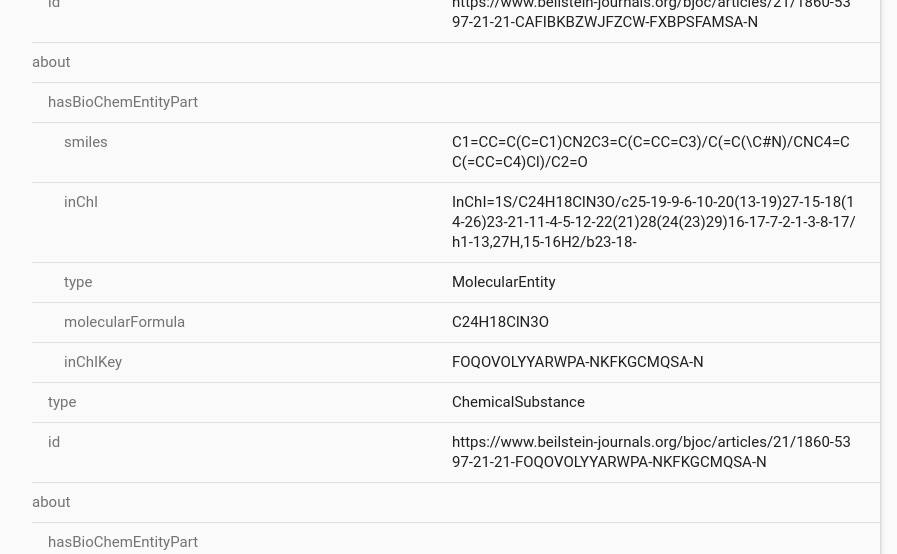Beilstein journals contain Bioschemas
Two weeks ago, the Beilstein Institute announced Bioschemas support in their journals:
We streamline the discoverability of your research by incorporating machine-readable chemical information into many of our published articles. This includes the conversion of chemical structures from submitted ChemDraw files to InChI strings and validating them using open-source tools.
The idea is far from new and has been around for two decades. But the two Beilstein journals (both diamond Open Access), actually integrated into their active publishing model. That has been trialed and put in action before. For example, there was (is?) Project Prospect (2007), chemical structure annotation in Nature Chemistry (2009), SMILES in the ACS Journal of Medicinal Chemistry (2014) (doi:10.1021/jm5002056), and FAIR chemical structures in the Journal of Cheminformatics (2021) (doi:10.1186/s13321-021-00520-4).
But this announcement is a new step. I like how validation of the chemical structures is part of the approach, and I like how they use the Bioschemas extention of schema.org. The last because they use two Bioschemas types/profiles that contributed to or initiated, respectively: MolecularEntity and ChemicalSubstance.
First stop for me is to check the schema.org annotation with a validation tool, like Google’s Rich Results Test. That gives an idea how they may have have their search engine pick it up. The test article I was given on LinkedIn is Xiao et al.’s Molecular diversity of the reactions of MBH carbonates of isatins and various nucleophiles (doi:10.3762/bjoc.21.21) in the Beilstein Journal of Organic Chemistry, and we indeed see the schema.org annotation show up:

And because of the use of open standards, extracting the information is not so hard with, for example here, Bacting (doi:10.21105/joss.02558), based on a 2022 script from the NanoSafety Cluster projects NanoCommons and SbD4Nano:
@Grab(group='io.github.egonw.bacting', module='managers-rdf', version='1.0.4')
@Grab(group='io.github.egonw.bacting', module='managers-ui', version='1.0.4')
@Grab(group='io.github.egonw.bacting', module='net.bioclipse.managers.jsoup', version='1.0.4')
bioclipse = new net.bioclipse.managers.BioclipseManager(".");
rdf = new net.bioclipse.managers.RDFManager(".");
jsoup = new net.bioclipse.managers.JSoupManager(".");
articles = [
args[0]
]
kg = rdf.createInMemoryStore()
for (article in articles) {
htmlContent = bioclipse.download(article)
htmlDom = jsoup.parseString(htmlContent)
// application/ld+json
bioschemasSections = jsoup.select(htmlDom, "script[type='application/ld+json']");
for (section in bioschemasSections) {
bioschemasJSON = section.html()
rdf.importFromString(kg, bioschemasJSON, "JSON-LD")
}
}
turtle = rdf.asTurtle(kg);
println "#" + rdf.size(kg) + " triples detected in the JSON-LD"
// println turtle
sparql = """
PREFIX schema: <http://schema.org/>
SELECT ?entity ?inchikey ?smiles WHERE {
?entity a schema:MolecularEntity .
OPTIONAL { ?entity schema:inChIKey ?inchikey }
OPTIONAL { ?entity schema:smiles ?smiles }
}
"""
results = rdf.sparql(kg, sparql)
for (i=1;i<=results.rowCount;i++) {
println "${results.get(i, "inchikey")}\t${results.get(i, "smiles")}"
}
The output is a simple table:
MGAPJMNPGGTFHJ-JEIPZWNWSA-N CN1C(=O)/C(=C/2\C3=CC(=CC=C3N(CC4=CC=CC=C4)C2=O)Cl)/C(=P(C5=CC=CC=C5)(C6=CC=CC=C6)C7=CC=CC=C7)C1=O
XEWMQVUVGAHESA-UHFFFAOYSA-N CC1=CC=C(C=C1)NC2=C(C3C4=CC(=CC=C4N(CC5=CC=CC=C5)C3=O)C)C(=O)N(C)C2=O
UVTJORFYHPGJDZ-PYCFMQQDSA-N CCCCN1C2=CC=C(C)C=C2/C(=C(\C#N)/CNC3=CC=C(C)C=C3)/C1=O
ILWGDUYVQRAMMG-PGMHBOJBSA-N CCCCN1C2=CC=C(C)C=C2/C(=C(\C#N)/CNC3=CC=C(C=C3)Cl)/C1=O
CAFIBKBZWJFZCW-FXBPSFAMSA-N CCCCN1C2=CC=C(C)C=C2/C(=C(\C#N)/CNC3=CC=CC=C3)/C1=O
UOJSFLANMVIMBV-UHFFFAOYSA-N CCCCN1C2=CC=C(C)C=C2C(C3=C(C(=O)N(C)C3=O)NC4=CC=C(C=C4)Cl)C1=O
VNJBTGZXAGHCSO-OAPYJULQSA-N COC(=O)/C(=C\1/C2=C(C=CC=C2)N(CC3=CC=CC=C3)C1=O)/C=P(C4=CC=CC=C4)(C5=CC=CC=C5)C6=CC=CC=C6
KJXQRAKSOANQTJ-GFMRDNFCSA-N CC1=CC=C(C=C1)NC/C(=C\2/C3=C(C=CC=C3)N(CC4=CC=CC=C4)C2=O)/C#N
IGEBJMZDOPBFGF-UHFFFAOYSA-N CCCCN1C2=CC=C(C)C=C2C(C3=C(C(=O)N(C)C3=O)NC4=CC=CC=C4)C1=O
SSANVPNESOMKOM-AWQADKOQSA-N C1=CC=C(C=C1)CN2C3=CC=C(C=C3/C(=C(/C#N)\C=P(C4=CC=CC=C4)(C5=CC=CC=C5)C6=CC=CC=C6)/C2=O)Cl
GEHWHSHQSIOZKL-NVQSTNCTSA-N CCCCN1C2=CC=C(C=C2/C(=C\3/C(=P(C4=CC=CC=C4)(C5=CC=CC=C5)C6=CC=CC=C6)C(=O)N(C)C3=O)/C1=O)Cl
PALRSQOHFLRWDH-UHFFFAOYSA-N CCCCN1C2=CC=C(C)C=C2C(C3=C(C(=O)N(C)C3=O)NC4=CC=C(C=C4)OC)C1=O
KBFODZMDSAFLFR-UHFFFAOYSA-N CN1C(=O)C(=C(C1=O)NC2=CC(=CC=C2)Cl)C3C4=CC(=CC=C4N(CC5=CC=CC=C5)C3=O)Cl
JCGAVVZYXDJPBU-GFMRDNFCSA-N CC1=C(C=CC=C1)NC/C(=C\2/C3=C(C=CC=C3)N(CC4=CC=CC=C4)C2=O)/C#N
DZFPCPDEQGLPLY-UHFFFAOYSA-N CCCCN1C2=CC=C(C)C=C2C(C3=C(C(=O)N(C)C3=O)NC4=CC=C(C)C=C4)C1=O
XMRNJCJUOXYXJU-DAFNUICNSA-N CC1=CC=C(C=C1)NC/C(=C\2/C3=CC(=CC=C3N(CC4=CC=CC=C4)C2=O)C)/C#N
SSDSNBBHEUUKGI-UHFFFAOYSA-N CC1=CC=C2C(=C1)C(C3=C(C(=O)N(C)C3=O)N(C)C4=CC=CC=C4)C(=O)N2CC5=CC=CC=C5
USFYPRDMNXMWPO-UHFFFAOYSA-N CCCCN1C2=CC=C(C)C=C2C(C3=C(C(=O)N(C)C3=O)NC4=CC=C(C=C4)Br)C1=O
XYHTWFULRHTEAG-MUGXBBEHSA-N CCCCN1C2=CC=C(C)C=C2/C(=C(/C#N)\C=P(C3=CC=CC=C3)(C4=CC=CC=C4)C5=CC=CC=C5)/C1=O
XALDZIBHNNIVAM-UHFFFAOYSA-N CCCCN1C2=CC=C(C)C=C2C(C3=C(C(=O)N(C)C3=O)NC4=C(C=CC=C4)O)C1=O
TUTWQHBRQPMLME-OAPYJULQSA-N COC(=O)/C(=C\1/C2=CC(=CC=C2N(CC3=CC=CC=C3)C1=O)Cl)/C=P(C4=CC=CC=C4)(C5=CC=CC=C5)C6=CC=CC=C6
IYEHFTMZZMIPRU-UHFFFAOYSA-N CC1=CC=C(C=C1)NC2=C(C3C4=CC(=CC=C4N(CC5=CC=CC=C5)C3=O)Cl)C(=O)N(C)C2=O
KBSDGNPLIPXCEX-UHFFFAOYSA-N CCCCN1C2=CC=C(C)C=C2C(C3=C(C(=O)N(C)C3=O)NCC4=CC=CC=C4)C1=O
BQGIUMITIGHBSD-UHFFFAOYSA-N CCCCNC1=C(C2C3=CC(=CC=C3N(CC4=CC=CC=C4)C2=O)C)C(=O)N(C)C1=O
PNSOLOPHIVUPOZ-MNDPQUGUSA-N CCCCNC/C(=C\1/C2=CC(=CC=C2N(CCCC)C1=O)C)/C#N
HLTBKJRJOIZCMJ-PYCFMQQDSA-N CCCCN1C2=CC=C(C)C=C2/C(=C(\C#N)/CN(C)C3=CC=CC=C3)/C1=O
FFLHFLUBMRBQTB-UHFFFAOYSA-N CCCCN1C2=CC=C(C=C2C(C3=C(C(=O)N(C)C3=O)NC4=CC=C(C)C=C4)C1=O)F
FOQOVOLYYARWPA-NKFKGCMQSA-N C1=CC=C(C=C1)CN2C3=C(C=CC=C3)/C(=C(\C#N)/CNC4=CC(=CC=C4)Cl)/C2=O
KLEPCAQFOXJLNV-UHFFFAOYSA-N CC1=C(C=CC=C1)NC2=C(C3C4=CC(=CC=C4N(CC5=CC=CC=C5)C3=O)Cl)C(=O)N(C)C2=O
That also made me realize that there are not chemical names in the annotation. That would be really useful to move things
forward. Then again, PubChem will likely just generate the IUPAC name, since they have access to such software anyway.
They have teamed up with PubChem which will index it, but I will be interested in seeing how to use this for
main subject annotation in Wikidata.
A final note for now, the model they use is annotate the article with chemical substances (ChemicalSubstance) with
(one or more?) molecular entities (`MolecularEntity’). That is a model that scales well to their other journal,
the Beilstein Journal of Nanotechnology. But scraping that is for another post.
You can use your Mastodon or other ActivityPub-based Fediverse-account to comment on this article by leaving a publicly visible reply to this associated post. Content warnings are supported. You can also delete your comments at any time by deleting your post on the Fediverse.